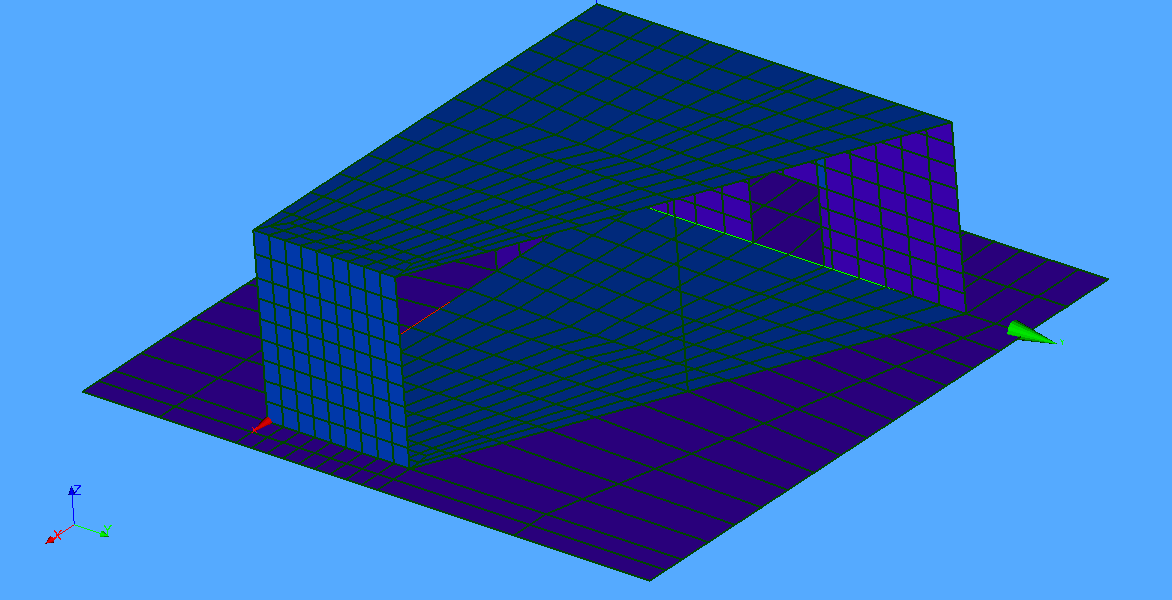1. Reference problem#
1.1. Geometry#
The geometry for sslx300abcd is a simplified building with three walls, a floor, a sole and a base. In addition, a portion of the ground is shown.
The building structure elements have a thickness of \(\mathrm{0,1}m\) while the base and the sole have a thickness of \(0.5m\) and \(0.35m\) respectively. The column has a rectangular cross section of \(0.2\mathrm{\times }0.2m\) and the beam has a section of \(0.15\mathrm{\times }0.325m\). The anchor point for the post is named \(S\). This point is not in contact with the floor.

Fig. 1.
The geometry for sslx300efghi is as follows:
Fig. 2.
1.2. Material properties#
For mechanical loads, the materials are isotropic elastic whose properties are:
Concrete: \(E=30000\mathit{MPa}\), \(\mathrm{\nu }=0.2\), \(\mathrm{\rho }=2400.\mathit{Kg}/{m}^{3}\), \(\mathrm{\alpha }=\mathrm{1,096e-5}/°C\)
Steel: \(E=200000\mathit{MPa}\), \(\mathrm{\nu }=0.\), \(\rho =\mathrm{7800.Kg}/{m}^{3}\), \(\mathrm{\alpha }=\mathrm{1,096e-5}/°C\)
For thermal loads, the properties of the materials are dependent on temperature:
Concrete: \(E=30000\mathit{MPa}\) to 20°C, \(E=15000\mathit{MPa}\) to 500°C, \(\mathrm{\nu }=0.3\) constant from 20°C to 500°C, constant from 20°C to 500°C, \(\mathrm{\alpha }=\mathrm{1,096e-5}/°C\) constant from 20°C to 500°C, constant from 20°C to 500°C, \(\mathrm{\lambda }=54.6W/m°C\), \(\mathrm{\rho }{C}_{p}=3.71e6J/m°C\) \(\mathrm{\rho }=2400.\mathit{Kg}/{m}^{3}\)
Steel: \(E=200000\mathit{MPa}\) to 20°C, \(E=100000\mathit{MPa}\) to 500°C, \(\mathrm{\nu }=0.2\) constant from 20°C to 500°C, constant from 20°C to 500°C, \(\mathrm{\alpha }=\mathrm{1,096e-5}/°C\) constant from 20°C to 500°C, constant from 20°C to 500°C, \(\mathrm{\lambda }=54.6W/m°C\), \(\mathrm{\rho }{C}_{p}=3.71e6J/m°C\) \(\rho =\mathrm{7800.Kg}/{m}^{3}\)
1.3. Boundary conditions and loads#
For sslx300abcd models, the walls of the building are connected to the frame. The group of nodes \(\mathit{CDG}\) belongs to the delayder. The group of nodes \(S\) is the end of the column on the raft side. The DDL in these two groups are embedded to block the movement of rigid bodies.
For sslx300efghi models, the structure is built with a mix of models:
embedding section \(x=0\)
continuity of translational movements on \(\mathrm{AB}\)
continuity of translational movements in \(C\)
equal rotation movements around \(z\) over \(\mathrm{C1}-\mathrm{C2}\)
for points \(M\) of the section (\(\mathrm{M1}\) \(\mathrm{M2}\) \(\mathrm{M4}\)) the translational displacements \(u(M)\) depend linearly on the rotational displacement \({\varphi }_{z}\) of the points \(P\) of \(\mathrm{AB}\)
\(u(M)=–{\varphi }_{z}(P)\mathrm{.}y+\mathrm{dx}(P)\)
The types of mechanical and thermal loads are the same in all models.
The mechanical loads are as follows:
Gravity
Constant pressure (for wind): FORCE_COQUE
Nodal force
Linear force
Imposed travel
Pressure dependent on coordinates
The thermal loads are as follows:
Constant/variable temperature field (CREA_CHAMP + AFFE_MATERIAU/AFFE_VARC)
Results with multiple temperature fields (CREA_RESU + AFFE_MATERIAU/AFFE_VARC)
The coefficients of the combinations are as follows:
load |
n1 |
n2 |
n2 |
n3 |
n3 |
n3 |
n3 |
n3 |
n9 |
n9 |
n12 |
n13 |
|
comb1 |
1.2 |
1.5 |
1.5 |
0 |
0 |
0 |
1 |
1 |
1 |
1 |
1 |
1 |
0 |
comb2 |
1.3 |
0 |
1.2 |
1.2 |
0 |
1.5 |
1.5 |
1.5 |
1 |
1 |
1 |
0 |
1 |
comb3 |
1.3 |
0 |
0 |
0 |
0 |
1.1 |
1 |
2 |
1.2 |
0 |
1.5 |
1.5 |
0 |